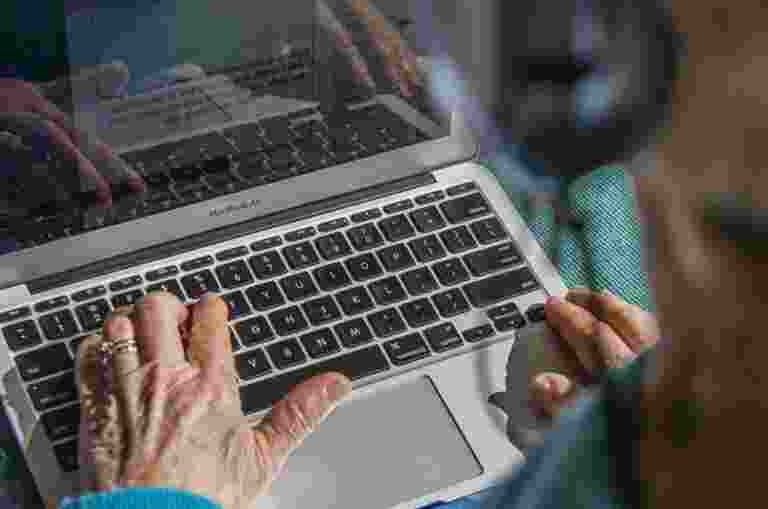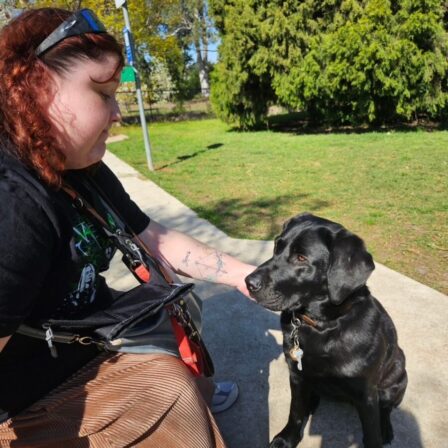News
Global Accessibility Awareness Day 2019

Today is Global Accessibility Awareness Day. Here at Guide Dogs NSW/ACT, we sat down with our Technology and Access Manager, Jodi Martin, to talk about why this day is important and some of the exciting ways we are assisting clients to access technology.
Can you tell everyone a little bit about you and your industry experience?
I have always been interested in science and health services, and started my career as an optometrist. After working in clinical practice for several years I became more and more interested in systems – both social and health – and how they impacted on a person’s access to care. I went back to study a Masters of Public Health and started working in public health optometry, specifically addressing avoidable blindness in the Asia-Pacific region. It is amazing how much a simple pair of glasses can change a person’s life. Soon I had a young family at home and travel was not so easy, so I looked for a role closer to home with Guide Dogs NSW/ACT. In my time at Guide Dogs I have learnt so much about disability in general and the impact of vision impairment in particular. I am enjoying bringing together my clinical background, public health work and systems knowledge to improve Guide Dogs services and access for people with vision impairment.
What is your role at Guide Dogs NSW/ACT?
My current role is Technology and Access Manager. I explore innovations in technology and how they can be applied to meet the needs of people with vision impairment. A lot of my work involves the intersection of technology and accessibility, working with developers, researchers and people with vision impairment to ensure mainstream technologies are accessible. I work with a fantastic team of people who have both expertise in various areas of accessibility, as well as a lived experience of vision impairment. As a team, we also advocate for accessibility of the physical environment and work with industries such as transport, health and cultural institutions, building organisational capacity to provide accessible services and spaces.

Today is Global Accessibility Awareness Day. Can you tell us why this day is important?
Global Accessibility Awareness Day (GAAD) gets technology designers, developers and researchers thinking about accessibility for people with disabilities. In my experience, these groups want to do the right thing and make their products accessible to everyone, but don’t know how to do it or where to start. Events like GAAD get the conversation started and raise awareness of accessibility.
What might people not realise about the access needs of someone with low vision or vision impairment when it comes to technology?
More and more, the news and entertainment we access online comes as short chunks of information, which are often presented visually. All those infographics, cat memes and news videos you share? They are probably not accessible for someone with a vision impairment. As a content producer, including audio description for videos and alternate text for images makes sense, because it widens your audience.
What are some of the exciting ways Guide Dogs NSW/ACT is assisting clients to access technology?
Clients have reported the main barriers to accessing technology are knowing that the technology exists and then learning how to use it. Here at Guide Dogs, we are trialling remote service delivery of our Assistive Technology training so that people in regional and remote areas have equal access to training in mainstream and vision-specific technologies.
Another barrier identified by clients is financial barriers, particularly for untried devices. Through the support of generous donors and grant funding, Guide Dogs are able to provide various technologies to clients on a trial or permanent basis to support access to social interaction, entertainment and information.

What’s something you would like to see offered or changed in the accessibility space in Australia?
People with vision impairment watch just as much TV as sighted audiences, yet Australia is the only English speaking country in the Organisation for Economic Co-operation and Development (OECD) which doesn’t offer audio description on free-to-air TV. The blindness sector in Australia has been campaigning for audio description for over 25 years. Recent government announcements have been positive in this regard, so I am looking forward to seeing equal access to television for people with vision impairment in the coming years.
Can you give an example of the way assistive technology has changed the life of someone with low vision or vision impairment?
We recently assisted a client to get a new technology named Aira through the NDIS. Using wearable smart glasses or a smart phone that beams live stream footage, Aira connects people who are vision impaired to a trained professional agent who then becomes their ‘eyes’, helping to navigate the built environment, colour match clothes, read a whiteboard, navigate a worksite, travel with confidence and so much more. This client now uses Aira to assist with completing her PHD, as she could not access her supervisor’s comments without using this app. For her it has been life changing. She now takes a couple of hours to complete feedback, graphs or diagrams, rather than days to do.
We also recently assisted a client who was new to the iPhone. We were able to assist him access the phone using VoiceOver and he became really savvy with a couple of the apps. Now he can make calls and texts using Siri, check the weather and tides before heading out to surf, take photos and videos of his Guide Dog, edit those videos and post them to a Facebook page he made for him and his dog.
This client went from being completely uncertain with his iPhone a year ago, to taking a call from a service provider on his VoiceOver-enabled Apple Watch, while standing on his paddle board in open water.
Technology can open up the world for people with disability, and that’s something that should be celebrated. Happy Global Accessibility Awareness Day!




